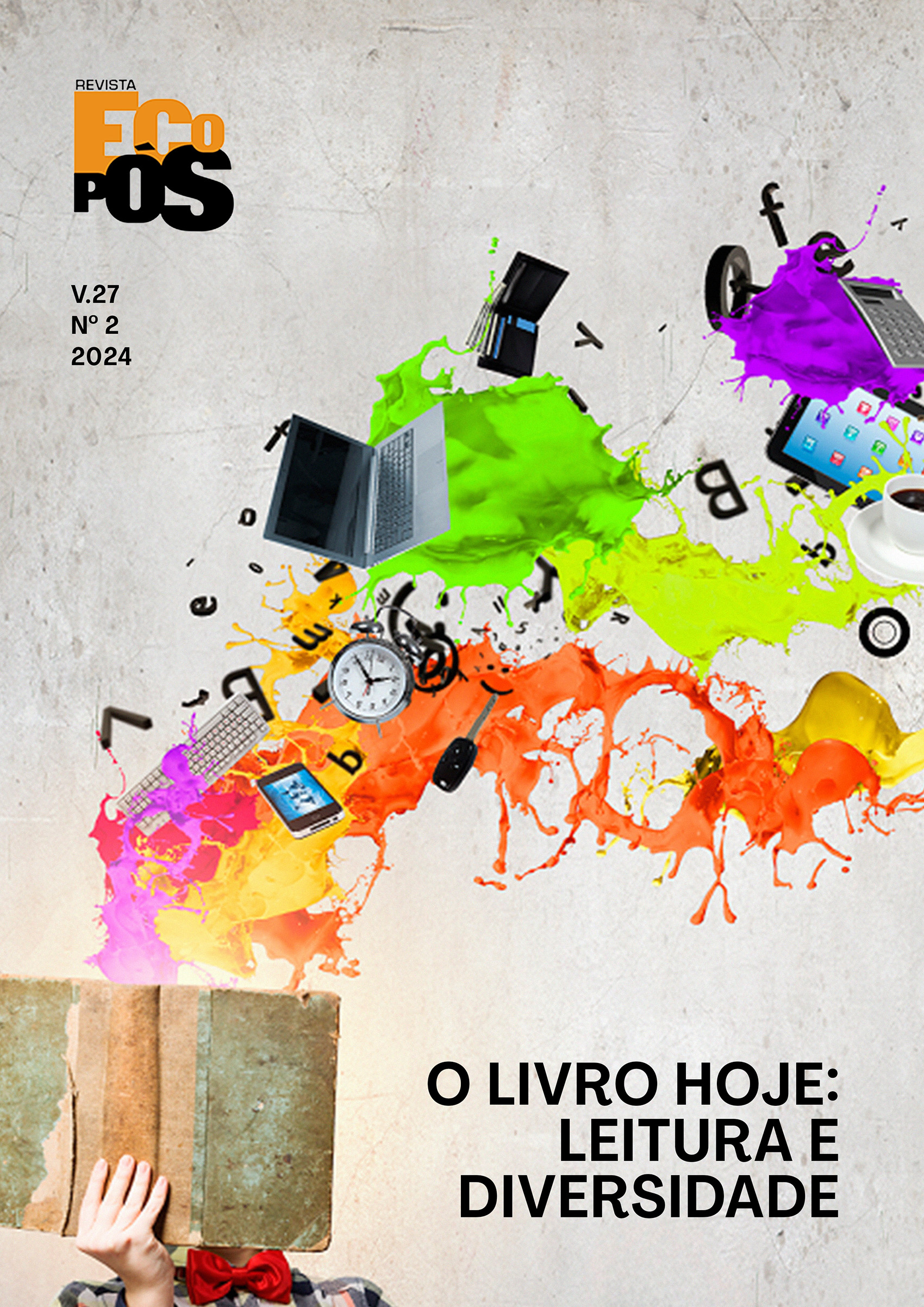La semiótica de la ironía en los videojuegos
Relacionando signos verbales, visuales y procedimentales en la creación de un enunciador absurdo
DOI:
https://doi.org/10.29146/eco-ps.v27i2.28070Palabras clave:
ironía, ironía verbal, ironía visual, procedimentalidad, videojuegosResumen
Este artículo propone un modelo analítico desde el cual la ironía, un concepto aquí considerado inicialmente en su configuración tradicional como "ironía verbal" y posteriormente expandido a "ironía semiótica", podría ser empleada como herramienta analítica formal para la poética de los videojuegos. En cuanto a la ironía verbal y/o visual, se adopta el marco teórico proporcionado por Ducrot (1987), Brait (2008) y Scott (2004), mientras que Bogost (2007, 2008) informa el marco teórico sobre la procedurabilidad como elemento compositivo específico de los juegos. Se sugiere entonces un método para analizar la ironía en los videojuegos que tiene en cuenta la articulación entre los tres lenguajes aquí identificados como más significativos para su composición: verbal, (audio)visual y procedimental. Luego, se prueba el método propuesto contra el caso concreto proporcionado por el videojuego Orgasm simulator (Molleindustria, 2003). Pudimos concluir que la ironía en los videojuegos se construye y codifica mediante la combinación de sistemas semióticos variados, y que su lenguaje procedimental específico también es capaz de crear significados irónicos.
Descargas
Citas
AARSETH, Espen. Cybertext: perspectives on ergodic literature. Baltimore: The Johns Hopkins University Press, 1997.
BOGOST, Ian. Persuasive games: the expressive power of videogames. Cambridge: The MIT Press, 2007.
BOGOST, Ian. The rhetoric of video games. In: SALEN, Katie (Ed.). The ecology of games: connecting youth, games, and learning. Cambridge: The MIT Press, 2008. p. 117-140.
BRAIT, Beth. Ironia em perspectiva polifônica. 2. ed. Campinas: Editora da Unicamp, 2008.
CARVALHO, Amorim de. Tratado de versificação portuguesa. Lisboa: Universitária, 1987.
CASELLI, Stefano; GIAPPONE, Krista Bonello Rutter; SCHELLEKENS, Jasper; GUALENI, Stefano. Satire at play: a game studies approach to satire. In: International Conference on the Foundations of Digital Games, 15., 2020, Bugibba, Malta. Proceedings […]. Nova Iorque: ACM, 4p. Disponível em: https://doi.org/10.1145/3402942.3403007. Acesso em: 02 maio 2024.
DUCROT, Oswald. O dizer e o dito. Tradução de Eduardo Guimarães. Campinas: Pontes, 1987.
ESTRELA. Manual de instruções Banco Imobiliário Brasil. São Paulo: Estrela, [s. d.]. Manual de instruções de jogo de tabuleiro. Disponível em: https://www.estrela.com.br/central-de-manuais. Acesso em: 05 maio 2023.
FRASCA, Gonzalo. Videogames of the oppressed: videogames as a means for critical thinking and debate. Dissertação (Mestrado em Information Design and Technology) – School of Literature, Communication and Culture, Georgia Institute of Technology. Georgia, 118 p., 2001.
FOSS, Sonja K. Theory of visual rhetoric. In: SMITH, Ken; MORIARTY, Sandra; BARBATSIS, Gretchen; KENNEY, Keith (Eds.). Handbook of visual communication: theory, methods, and media. Mahwah: Lawrence Arlbaum Associates, 2005. p. 141-152.
HUTCHEON, Linda. Teoria e política da ironia. Belo Horizonte: UFMG, 2000.
JUUL, Jesper. Half-real: videogames entre regras reais e mundos ficcionais. Tradução de Alan Richard da Luz. São Paulo: Blucher, 2019.
MACHADO, Ida Lucia. Irony as a communicative and argumentative strategy. Bakhtiniana, São Paulo, v. 9, n. 1, p. 118-137, jan./jul. 2014.
MOLLEINDUSTRIA. Orgasm simulator. [S. l.]: Molleindustria, 2003. jogo eletrônico. Disponível para download em: https://www.molleindustria.org/en/orgasm-simulator/. Acesso em: 05 maio 2023.
MURRAY, Janet H. Hamlet no holodeck: o futuro da narrativa no ciberespaço. Tradução de Elissa Khoury Daher e Marcelo Fernandez Cuzziol. São Paulo: Itaú Cultural: Editora Unesp, 2003.
SAUSSURE, Ferdinand de. Curso de linguística geral. Tradução de Antônio Chelini, José Paulo Paes e Izidoro Blikstein. 28. ed. São Paulo: Cultrix, 2012.
SCHELLEKENS, Jasper; CASELLI, Stefano; GUALENI, Stefano; GIAPPONE, Krista Bonello Rutter. Satirical game design: the case of the boardgame Construction BOOM! In: International Conference on the Foundations of Digital Games, 15., 2020, Bugibba, Malta. Proceedings […]. Nova Iorque: ACM, 12 p. Disponível em: https://doi.org/10.1145/3402942.3403008. Acesso em: 02 maio. 2024.
SCOTT, Biljana. Picturing irony: the subversive power of photography. Visual Communication, v. 3, n. 1, p. 31-59, 2004. Disponível em: https://doi.org/10.1177/1470357204039597. Acesso em: 05 maio. 2023.
SICART, Miguel. Against procedurality. Game Studies, v. 11, n. 3, 2011. Disponível em: http://gamestudies.org/1103/articles/sicart_ap. Acesso em: 05 maio 2023.
Descargas
Publicado
Cómo citar
Número
Sección
Licencia
Derechos de autor 2024 Natalia Corbello, Márcio Prado

Esta obra está bajo una licencia internacional Creative Commons Atribución-NoComercial-SinDerivadas 4.0.
Aos autores pertence o direito exclusivo de utilização ou reprodução.
Você tem o direito de:
- Compartilhar — copie e redistribua o material em qualquer meio ou formato.
- Adaptar — remixar, transformar e construir sobre o material para qualquer filme, mesmo comercial.
O licenciante não pode revogar esses direitos, desde que você respeite os termos da licença.
De acordo com os seguintes termos:
- Atribuição — Você deve dar o devido crédito, fornecer um link para a licença e indicar se essas alterações foram feitas. Você pode fazê-lo de qualquer maneira razoável, mas não de maneira que sugira que o licenciante endosse ou aprove seu uso.
- Sem restrições adicionais — Você não pode aplicar termos legais ou medidas de natureza tecnológica que restrinjam legalmente outros de fazer algo que a licença permite.
Aviso: A licença pode não fornecer todas as permissões necessárias para o uso pretendido. Por exemplo, outros direitos, como publicidade, privacidade ou direitos morais, podem limitar a maneira como você usa o material.











